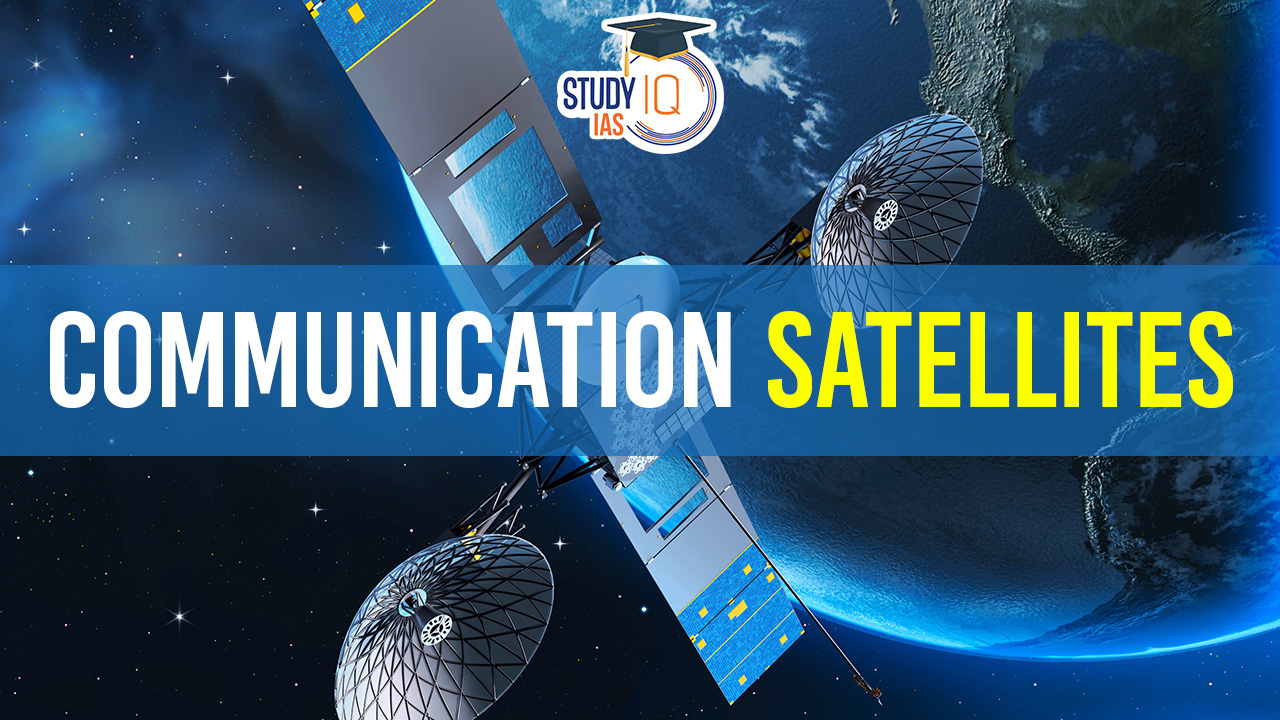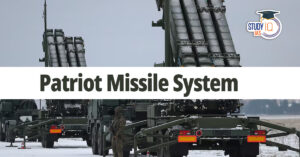Table of Contents
Communication satellites, often referred to simply as “comsats,” are artificial satellites designed and placed in orbit around the Earth to facilitate various forms of telecommunication, including television broadcasting, internet connectivity, telephone service, and data transmission. In this article, we will discuss Communication Satellites, Examples, Types, and Indian Scenario.
Communication Satellites
Communication satellites, located in geostationary and low Earth orbits, play a pivotal role in global telecommunications. Equipped with transponders, they relay signals for voice, data, TV, and internet services. Some constellations, like Starlink and OneWeb, provide low-latency broadband. These satellites have finite lifespans and require periodic replacement. Geostationary slots are allocated by the ITU to prevent interference. Despite challenges like space debris, cybersecurity threats, and terrestrial competition, communication satellites remain vital for global connectivity, demanding ongoing technological advancements and regulations.
We’re now on WhatsApp. Click to Join
Satellite Communication Example
Satellite communication is used in various applications across different industries. Here are several examples:
Direct-to-Home (DTH) Television
Satellite TV providers like DIRECTV and Dish Network use geostationary satellites to transmit television signals directly to users’ homes, offering a wide range of channels and content.
Global Positioning System (GPS)
GPS relies on a constellation of satellites to provide accurate location and navigation information to users worldwide for activities like driving, aviation, and maritime navigation.
Internet via Satellite
In remote areas or on ships and airplanes, satellite internet services, such as HughesNet and Viasat, use communication satellites to provide internet access when traditional terrestrial connections are unavailable.
Satellite Radio
Services like SiriusXM use satellites to deliver digital radio broadcasts to subscribers, offering a vast selection of music, news, sports, and entertainment channels.
Weather Forecasting
Weather satellites in polar orbits capture imagery and data used by meteorologists to monitor and predict weather conditions, including tracking storms and hurricanes.
Remote Sensing
Earth observation satellites like those in the Landsat program collect data for applications such as agriculture, forestry, disaster monitoring, and urban planning.
Military and Defense
Defense agencies use communication satellites for secure and reliable communications, reconnaissance, surveillance, and navigation.
Search and Rescue
Satellites, like the COSPAS-SARSAT system, assist in locating and rescuing distressed ships, aircraft, and individuals through distress beacons and geolocation technology.
Environmental Monitoring
Satellites monitor environmental factors like deforestation, climate change, and pollution, providing valuable data for research and policy decisions.
Telemedicine
In remote or underserved areas, satellite communication enables telemedicine, connecting healthcare providers with patients through video conferencing and remote monitoring.
Agriculture
Satellite technology aids precision agriculture by providing data on crop health, soil conditions, and weather patterns to optimize farming practices.
Aircraft Communication
Commercial airlines use satellite communication for cockpit data transmission and passenger connectivity, ensuring efficient flight operations and in-flight entertainment.
Types of satellite communication
Satellite communication encompasses a wide range of applications and technologies. Here are some of the common types of satellite communication:
Geostationary Earth Orbit (GEO) Satellites
These satellites orbit at approximately 36,000 kilometers above the Earth’s equator.
They remain in a fixed position relative to the Earth’s surface, making them ideal for applications like television broadcasting, weather monitoring, and global communication networks.
Low Earth Orbit (LEO) Satellites
LEO satellites are much closer to Earth, typically at altitudes ranging from 160 to 2,000 kilometers.
They are used for various purposes, including Earth observation, scientific research, and global internet coverage, as they offer low latency due to their proximity to the Earth.
Medium Earth Orbit (MEO) Satellites
MEO satellites orbit at altitudes between LEO and GEO, typically around 10,000 to 20,000 kilometers.
They are commonly used in global navigation systems like the Global Positioning System (GPS).
Polar Orbit Satellites
These satellites pass over the Earth’s poles in a north-south direction and are often used for Earth observation, environmental monitoring, and remote sensing.
Communication Satellites
These satellites provide the backbone for global telecommunications networks, including voice and data services, broadband internet, and television broadcasting.
Navigation Satellites
Navigation satellite systems like GPS, GLONASS, Galileo, and Beidou use satellite constellations to provide precise location and timing information for a wide range of applications, from navigation and mapping to emergency services.
Earth Observation Satellites
These satellites are equipped with sensors and cameras to monitor the Earth’s surface and collect data for various purposes, such as weather forecasting, environmental monitoring, and disaster management.
Scientific Satellites
Scientific satellites are launched to conduct experiments and observations in space, often for astronomy, astrophysics, and planetary exploration.
Military Satellites
These satellites are used for secure communication, reconnaissance, and surveillance by military organizations. They are often equipped with advanced encryption and anti-jamming capabilities.
Space Telescopes
Space telescopes like the Hubble Space Telescope are placed in orbit to observe distant celestial objects and capture high-resolution images of the universe.
Interplanetary Satellites
These spacecraft are sent to explore other planets, moons, and celestial bodies within our solar system. Examples include the Mars rovers and the Voyager probes.
Satellite-Based Internet Constellations
Companies like SpaceX (Starlink), OneWeb, and Amazon (Project Kuiper) are launching large constellations of LEO satellites to provide global internet coverage, especially in remote and underserved areas.
How Does Communication Satellite Work?
Communication satellites work by relaying signals between two or more ground stations, facilitating various types of communication, such as telephone calls, television broadcasts, internet data, and more. Here’s an overview of how communication satellites operate:
Uplink Transmission
Communication begins at a ground station, often referred to as an “uplink station.” These ground stations transmit data to the satellite. In the case of satellite television, for example, the uplink station sends television programs and other content to the satellite for distribution.
Satellite Orbit
The communication satellite orbits the Earth in a specific path, known as an orbit. Geostationary Earth Orbit (GEO) satellites orbit at an altitude of approximately 36,000 kilometers, remaining stationary relative to the Earth’s surface. Low Earth Orbit (LEO) and Medium Earth Orbit (MEO) satellites are other common options used for different purposes.
Signal Processing Communication satellites are equipped with transponders. A transponder is a device that receives the uplinked signal, processes it, amplifies it, and retransmits it back to Earth. This is done at different frequencies to avoid interference with the incoming and outgoing signals.
Downlink Transmission
The retransmitted signal is sent back to Earth to designated ground stations, often referred to as “downlink stations” or “receive stations.” These stations have satellite dishes or antennas that receive the signals from the satellite.
Antenna Alignment
For effective communication, the ground station’s receiving antenna must be aligned accurately with the satellite’s position in the sky.
Signal Distribution
Once received by the downlink station, the signal can be distributed to various endpoints, such as television broadcast networks, internet service providers, or telephone exchanges.
Orbital Considerations
GEO satellites are positioned in such a way that they cover specific regions of the Earth. Multiple GEO satellites are often used to provide global coverage. LEO and MEO satellites, on the other hand, move more rapidly across the sky but offer lower latency and can provide global coverage with a constellation of multiple satellites.
Handoff Between Satellites (in LEO/MEO Constellations)
In LEO and MEO satellite constellations, when one satellite moves out of the line of sight, the communication is handed off to the next satellite in the constellation to maintain a continuous connection.
Satellite communication in India
Indian National Satellite (INSAT)
The Indian National Satellite (INSAT) system, boasting nine fully operational communication satellites in geostationary orbit, ranks among the largest domestic communication satellite networks in the Asia-Pacific region.
Revolutionizing India’s Communications Sector
A watershed moment occurred in 1983 with the launch of INSAT-1B, setting the stage for a profound transformation in India’s communications landscape. This transformation has endured and evolved over the years.
Diverse and Extensive Capabilities
Featuring an array of over 200 transponders operating in the C, Extended C, and Ku bands, the INSAT system serves as a versatile platform. It provides critical support for a wide spectrum of applications, including telecommunications, television broadcasting, satellite newsgathering, societal programs, weather forecasting, disaster preparedness, and warnings, as well as Search and Rescue operations.
The INSAT system’s multifaceted capabilities have made it a cornerstone of India’s technological and communication infrastructure, contributing significantly to various sectors and enhancing the nation’s connectivity and resilience.
Communication Satellites of ISRO
| Satellite | Launch Date | Launch Vehicle | Application |
| CMS-01 | Dec 17, 2020 | PSLV-C50/CMS-01 | Communication |
| GSAT-30 | Jan 17, 2020 | Ariane-5 VA-251 | Communication |
| GSAT-31 | Feb 06, 2019 | Ariane-5 VA-247 | Communication |
| GSAT-7A | Dec 19, 2018 | GSLV-F11 / GSAT-7A Mission | Communication |
| GSAT-11 Mission | Dec 05, 2018 | Ariane-5 VA-246 | Communication |
| GSAT-29 | Nov 14, 2018 | GSLV Mk III-D2 / GSAT-29 Mission | Communication |
| GSAT-6A | Mar 29, 2018 | GSLV-F08/ GSAT-6A Mission | Communication |
| GSAT-17 | Jun 29, 2017 | Ariane-5 VA-238 | Communication |
| GSAT-19 | Jun 05, 2017 | GSLV Mk III-D1/ GSAT-19 Mission | Communication |
| GSAT-9 | May 05, 2017 | GSLV-F09 / GSAT-9 | Communication |
| GSAT-18 | Oct 06, 2016 | Ariane-5 VA-231 | Communication |
| GSAT-15 | Nov 11, 2015 | Ariane-5 VA-227 | Communication, Navigation |
| GSAT-6 | Aug 27, 2015 | GSLV-D6 | Communication |
| GSAT-16 | Dec 07, 2014 | Ariane-5 VA-221 | Communication |
| GSAT-14 | Jan 05, 2014 | GSLV-D5/ GSAT-14 | Communication |
| GSAT-7 | Aug 30, 2013 | Ariane-5 VA-215 | Communication |
| GSAT-10 | Sep 29, 2012 | Ariane-5 VA-209 | Communication, Navigation |
| GSAT-12 | Jul 15, 2011 | PSLV-C17/ GSAT-12 | Communication |
| GSAT-8 | May 21, 2011 | Ariane-5 VA-202 | Communication, Navigation |
| INSAT-4CR | Sep 02, 2007 | GSLV-F04 / INSAT-4CR | Communication |
| INSAT-4B | Mar 12, 2007 | Ariane5 | Communication |
| INSAT-4A | Dec 22, 2005 | Ariane5-V169 | Communication |
| HAMSAT | May 05, 2005 | PSLV-C6/CARTOSAT-1 /HAMSAT | Communication |
| EDUSAT | Sep 20, 2004 | GSLV-F01 / EDUSAT(GSAT-3) | Communication |
| INSAT-3E | Sep 28, 2003 | Ariane5-V162 | Communication |
| GSAT-2 | May 08, 2003 | GSLV-D2 / GSAT-2 | Communication |
| INSAT-3A | Apr 10, 2003 | Ariane5-V160 | Climate & Environment, Communication |
| KALPANA-1 | Sep 12, 2002 | PSLV-C4 /KALPANA-1 | Climate & Environment, Communication |
| INSAT-3C | Jan 24, 2002 | Ariane5-V147 | Climate & Environment, Communication |
| GSAT-1 | Apr 18, 2001 | GSLV-D1 / GSAT-1 | Communication |
| INSAT-3B | Mar 22, 2000 | Ariane-5G | Communication |
| INSAT-2E | Apr 03, 1999 | Ariane-42P H10-3 | Communication |
| INSAT-2C | Dec 07, 1995 | Ariane-44L H10-3 | Communication |
| INSAT-2B | Jul 23, 1993 | Ariane-44L H10+ | Communication |
| INSAT-2A | Jul 10, 1992 | Ariane-44L H10 | Communication |
| INSAT-1D | Jun 12, 1990 | Delta 4925 | Communication |
| INSAT-1B | Aug 30, 1983 | Shuttle [PAM-D] | Communication |
Development of Satellite Communication
The development of satellite communication has been a fascinating journey, marked by numerous technological advancements and milestones. Here is a brief overview of the key stages in the evolution of satellite communication:
| Development Stage | Key Highlights |
| Conceptualization | Arthur C. Clarke’s concept of geostationary satellites (1945). |
| The First Satellites | Launch of Sputnik 1 (1957) and Echo 1 (1960). |
| Early Communication Satellites | Introduction of Syncom series, first geostationary satellites. |
| Commercialization and Global Expansion | Launch of Intelsat system (1965) and expansion of global coverage. |
| Digital Revolution | Transition to digital technology, DTH satellite TV, and broadband. |
| Internet and Global Connectivity | High-throughput satellites, satellite-based internet. |
| Advancements in Technology | Miniaturization, solar power, propulsion systems. |
| Space Commercialization | Growth of commercial space industry and private initiatives. |
Satellite Communication Uses
Satellite communication serves a wide range of uses and applications across various sectors. Here are some of the primary uses of satellite communication:
- Telecommunications: Satellite communication is a vital component of global telecommunications networks, providing long-distance voice and data transmission. It’s particularly important in remote and underserved areas where terrestrial infrastructure is lacking.
- Television Broadcasting: Communication satellites are extensively used for television broadcasting, including direct-to-home (DTH) and cable TV services. They enable the distribution of television channels to a wide audience.
- Satellite Internet: Satellites are used to deliver internet services to remote and rural areas, bridging the digital divide. High-throughput satellites (HTS) are increasingly employed for broadband internet access.
- Global Navigation and Positioning: Satellite navigation systems like GPS (Global Positioning System) are used for precise location and timing information in applications ranging from navigation and mapping to aviation and agriculture.
- Earth Observation and Remote Sensing: Earth observation satellites provide data for various purposes, including weather forecasting, environmental monitoring, disaster management, agriculture, and urban planning.
- Scientific Research: Satellites are used for scientific research and exploration, including studying the Earth’s atmosphere, climate, and geology, as well as missions to other planets and celestial bodies.
- Space Exploration: Interplanetary missions rely on communication satellites to transmit data and images from distant locations, such as Mars rovers and space probes.
- Maritime and Aviation Communication: Satellite communication supports communication and tracking for ships and aircraft, ensuring safety and efficient operation.
- Defense and Military: Military organizations use dedicated communication satellites for secure and reliable voice and data transmission, including command and control, reconnaissance, and surveillance.
- Emergency Services: Satellites play a crucial role in disaster management by providing communication during emergencies, such as natural disasters and search and rescue operations.
- Agriculture: Satellite data is used in precision agriculture to optimize crop management, monitor soil conditions, and predict crop yields.
- Environmental Monitoring: Satellites help track environmental changes, such as deforestation, pollution, and climate patterns, contributing to conservation and environmental protection efforts.
- Aid and Development: Satellite communication supports humanitarian efforts by enabling communication in remote and disaster-affected regions and facilitating relief operations.
- Energy and Utilities: Satellites assist in monitoring energy infrastructure, such as pipelines, power grids, and renewable energy facilities, enhancing efficiency and maintenance.
- Telemedicine: Satellite communication enables telemedicine services, connecting healthcare professionals with patients in remote and underserved areas.
- Transport and Logistics: The transportation and logistics industry relies on satellite communication for tracking and managing vehicles, goods, and supply chains.
Importance of Satellite Communication
Satellite communication plays a vital role in today’s interconnected world, providing numerous benefits and serving as a critical component of various industries and sectors. Here are some of the key reasons why satellite communication is important:
- Global Connectivity: Bridges geographical gaps, connecting remote and underserved areas.
- Disaster Response: Ensures communication and coordination during emergencies and natural disasters.
- Remote Access: Provides internet, telemedicine, and educational resources to isolated communities.
- Maritime and Aviation Safety: Enhances safety at sea and in the skies through navigation and communication.
- Weather Forecasting: Improves the accuracy of weather forecasts for agriculture and public safety.
- Space Exploration: Supports interplanetary missions, space exploration, and data transmission from distant planets.
- Global Navigation: Precise location and timing data for transportation and geolocation-based services.
- National Security: Enables secure military communications, reconnaissance, and surveillance.
- Telecommunication Reliability: Acts as a backup for terrestrial networks during outages and emergencies.
- Television Broadcasting: Allows global broadcasting of television channels and content.
- Environmental Monitoring: Monitors deforestation, pollution, climate change, and natural resource management.
- Agriculture and Resource Management: Supports precision agriculture and sustainable resource use.
- Scientific Research: Facilitates scientific exploration, including astronomy and climate studies.
- Educational Outreach: Enhances remote learning and educational content distribution.
- Business and Commerce: Supports international trade, financial transactions, e-commerce, and supply chain management.
- Public Health: Enables telemedicine and telehealth services, especially in remote areas.
- Technological Advancement: Drives innovation in satellite technology and applications.
- Economic Growth: Contributes to economic development and global collaboration.
- Quality of Life: Enhances safety, access to services, and quality of life for people worldwide.
Communication Satellites UPSC
Satellite communication is essential for global connectivity, including telecommunications, television broadcasting, and internet access. It plays a crucial role in disaster response, navigation (e.g., GPS), weather forecasting, and space exploration. Communication satellites, like those operated by ISRO in India, enhance national security and support various sectors, from agriculture to scientific research. They bridge gaps in remote and underserved areas, ensuring economic growth and technological advancement while contributing to the quality of life and public health. In summary, satellite communication is pivotal for modern connectivity, safety, and advancement in numerous fields.


 Patriot Missile System: Features, Capabi...
Patriot Missile System: Features, Capabi...
 Women in STEM Careers, Importance, Oppor...
Women in STEM Careers, Importance, Oppor...
 GLP-1 Drugs: Uses, Genesis and Developme...
GLP-1 Drugs: Uses, Genesis and Developme...





















